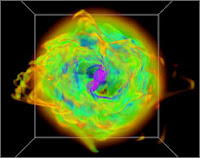 Obesity has apparently reached galactic proportions, apparently — even stars have a problem with over-eating, a stellar mystery that has astronomers asking how some stars grow to be so large. A supercomputer scientist team may have the answer, in a demonstration of how nature can take something simple and make it complex.
Obesity has apparently reached galactic proportions, apparently — even stars have a problem with over-eating, a stellar mystery that has astronomers asking how some stars grow to be so large. A supercomputer scientist team may have the answer, in a demonstration of how nature can take something simple and make it complex.
About 7,500 light years away resides the star Eta Carinae, first noted in a star catalogue by the venerable astronomer Edmond Halley (best known for Halley's comet) in 1677. Since then, the star has bedazzled astronomers by brightening every century or so, most notably in an 1843 outburst that briefly made it the brightest star in the sky, despite its distance (one light year is about 5.9 trillion miles.) To add to the mystery, the star is a porker, about 120 times heavier than the sun, embedded in a star-forming gas cloud called the Carina Nebula.
University of California, Berkeley, astronomer Nathan Smith proposed last year in the journal Nature that 1843 outburst arose from an explosion deep in the star that spat out a blob of star-stuff perhaps ten times as heavy as the sun. The report counts the explosion as a newly-discovered mechanism for how gigantic stars, which only live a million years or so, start to break down prior to their final implosion (the process that forms black holes.)
But that left the bigger mystery, which is how do stars like Eta Carinae get so big in the first place? "We see stars at least 120 times that of the Sun throughout space, but the mechanism by which the most massive stars form is a longstanding mystery," says astronomer Mark Krumholz of the University of California, Santa Cruz. Astronomers know that stars form by the clumping together of gas clouds. These "proto-stars" ignite through nuclear fusion once they become about 80 times heavier than the planet Jupiter.
Stars are thereafter balancing acts, Krumholz explains, in which the inward pull of gravity from the center of a star fights against the outward "radiation pressure" from light and other electromagnetic radiation emitted by its nuclear furnace. Where the push and pull of the two forces balance out, you have the surface of the star.
FIND MORE STORIES IN: University of California | Berkeley | Science | Jupiter | Santa Cruz | Nathan Smith | Alka-Seltzer | Edmond Halley | Eta Carinae
For astronomers, all this works out nicely to produce young stars up to about 20 times heavier than the sun. But once the star grows larger, the math stops working and the radiation force pressure overwhelms the gravitational urge to pull in gas from outside the star. "But still, we see them, so they must grow somehow," Krumholz says.
So, to crack the mystery, he and his colleagues decided to grow their own super-massive star. Inside a rented super-computer, they programmed the simplest start for one, a circular cloud of gas about 100 times the weight of the sun. In the three-dimensional simulation, a first, the cloud collapsed into a circular disk and sparked a young star, which "grew" to 11 times the weight of the sun in 20,000 simulated years, just as theory predicted. Past that point, things starting getting interesting. First the disc surrounding the star grew spiral arms that helped shovel gas into its maw for another 6,000 years, until it grew to 17 times heftier than our sun.
At that point, the radiation pressure from the star began to out-battle the force of gravity. But instead of pushing the disc gas away evenly, the radiation pressure blew out powerful "bubbles" along the axes of the star. "Almost all gas falling onto the protostar struck the walls of the bubbles, where it was shocked and swept up into the bubble walls. However, this did not slow accretion in our simulation, because the gas that struck the bubble walls eventually traveled along the margin until it reached the disk, at which point it continued to accrete onto the star," reports the study released by the journal Science. "The trick is to look at the star in three dimensions where you see these bubbles develop," Krumholz says.
Avoiding any jokes about Alka-Seltzer, Krumholz and colleagues find the bubbles give the radiation pressure a way to escape, while letting the star continue to gobble up more star-forming stuff. Interestingly, a second stars started to form in the gas disk as the process becomes more unbalanced with the strengthening of the radiation bubbles. Why massive stars always have companions was another mystery, one the simulation thereby also cleared up, a two-fer for astronomy. (A third star actually formed in the simulation, but that unfortunate orb fell back into its parent star.)
After about 57,000 years of simulated time, the researchers halted the star's growth, finding it had quite burgeoned to about 70 times the mass of the sun. "It ran for 40 days and 40 nights, when you add it up," of expensive supercomputer time, Krumholz says.
So that mystery solved, the question of why super-massive stars top off at about 120 times the weight of the sun remains. "The size of a star in our simulation is only limited by the size of the starting gas cloud," Krumholz says. He and others suspect some still-undiscovered mechanism starts knocking out interior explosions of star stuff, like those seen from Eta Carinae, once they reach the most overstuffed sizes, Krumholz says. "You can lose mass in a hurry by spitting out 10-solar-mass eruptions, after all."
by:usa today
Tuesday, January 20, 2009
Subscribe to:
Post Comments (Atom)




